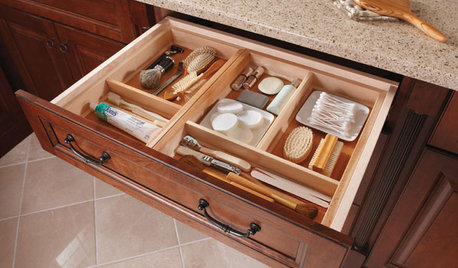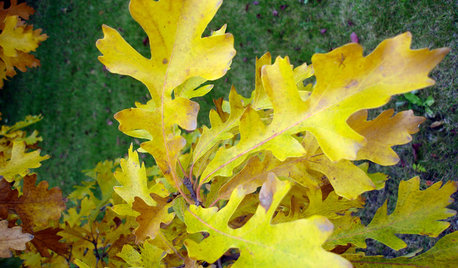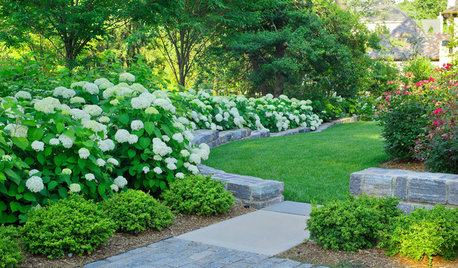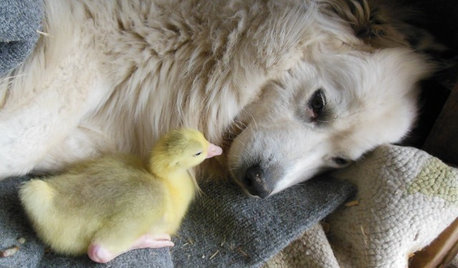Toamtoes in Oklahoma: Part III, Successful Growth
Okiedawn OK Zone 7
16 years ago
Featured Answer
Sort by:Oldest
Comments (8)
plantermunn
16 years agolast modified: 9 years agoOkiedawn OK Zone 7
16 years agolast modified: 9 years agoRelated Discussions
Success With Cucurbit Family Members
Comments (12)Steffie, I wish we were next-door neighbors, too, but since we live more than just a few miles apart, we'll have to be cyber-neighbors. :) I am far from an expert, just a gardening nut who relentlessly tries to learn and understand and improve what I do as I go along. And, lest you think I have a perfect yard or landscape, let me disabuse you of that notion right away! I have weeds I can't defeat, bermuda that invades beds it shouldn't, trees and shrubs that outgrow the spot where they were oh-so-carefully placed, plants that just give up and die and I never really figure out why they died, etc., etc., etc. Discussing things with my Oklahoma friends and neighbors here at this forum helps me keep things in perspective. It educates me. It offers me encouragement on those days when everything seems wrong and nothing seems right. It gives me new ideas and inspiration. Every one of you is better than me at something that is gardening-related. And, believe me, I know it. So, for example, when one of you writes about hydangeas, I pay attention and soak up everything you say, because one of these days I WILL succeed with hydranges. Have you ever noticed that most all gardeners are just the kindest, most giving and sharing people? You know what I'm talking about.....you see someone working out in the yard and you stop to tell them that you love their irises....and they dig up a couple on the spot and insist you take them, saying...."I needed to divide them anyway". Or, you drop off some of your extra tomatoes and a carton of hen or guinea eggs at a neighbor's house.....and they won't let you leave until you have some of their 'extra' fresh corn and peaches right off the tree, and some bacon from a hog they slaughtered and processed. I've yet to meet a fellow gardener who wouldn't give you the shirt off their back, or loan you their rototiller, or give you tons and tons of advice and ideas, and then apologize to you if their ideas don't work for you. So, I am very touched when you say that I am your hero. That is the nicest thing anyone has ever said to me. You have to believe me when I say that I feel the same way about each and every one of you. I believe we are all heroes for one another, and I believe that is how God meant for it to be. Life in this world can be cold, hard, and cruel, at times. For those of us who love to garden, the love, friendship, caring and support we receive from one another is a beautiful gift And, it is a gift I appreciate each and every day. Hugs to you, Steffie, and hugs to all the rest of you too. Dawn...See MoreRecommended Plants for Oklahoma
Comments (79)Hi Rhoni Ann, Lots of people are painting red/orangey-red brick homes nowadays. If you're a fan of the Fixer-Upper TV show on HGTV, you've probably noticed that Chip and Joanna Gaines have totally transformed the exterior of many brick homes by painting that red/red-orange brick in all sorts of lovely shades of gray, creamy white or beige. After they add new trim and sometimes shutters and window boxes (depending on the style of the home and the look they're going for), along with new landscaping, those homes look just as transformed on the exterior as they are on the interior. Keep in mind that once you paint your brick, assuming you are going with a lighter color, it will reflect heat and light, but I have found there are lots of plants which grow well on the hotter west and south sides of homes that what a person might expect. First of all, if you will amend your clay with compost or some other organic material before you plant, then your plants will do so much better that it will blow your mind and you won't have to water nearly as much. We have dense, thick red clay (the kind you could use to make clay pots) that had zero organic matter when I tested it when we moved here in 1999. When they dug the holes for our percolation test for our septic system when we built our house, most all of the water remained in the holes after 24-hours, which explains why we have a lagoon instead of leach lines. Along our south and west facing walls, cannas have done really well in only lightly amended clay. If you plant the tall ones that get 4-7' tall, they will form their own mini-wall along the bring wall, and they don't really mind the heat as long as you water them occasionally in summer. They die back in winter, but you can cut off the ugly dead foliage at the ground so you don't have to look at it all winter long. Cannas are very strong, resilient plants, fitting into my favorite category of plants that I describe in this manner: they won't die and you can't kill them. In front of those taller cannas, you could the short, compact evergreen shrubs of your choice so you'd have something green there year-round. Some of the shorter varieties of hollies would work, and hollies come with many different leaf shapes from the very small leaves of yaupon hollies to the larger leaves of other forms of holly. If you don't want evergreen shrubs on the west side of the house, you could plant daylilies, lantana, gomprena (aka globe amaranth), zinnias, cosmos and some perennial members of the salvia family. All of these do well in well-amended, well-draining soil and only need moderate amounts of water in summer as long as they are well mulched. Or, you could plant ground cover type plants that thrive in full sun. Purple wintercreeper is a lovely greenish groundcover that is low maintenance. We just cut ours back to the ground with the string trimmer once or twice a year. It turns purplish-green in the cold season. Its flowers are not very obvious but then they give you lovely little berries. Hollies, by the way, are one of my favorite plants for clay soil because once they are established many of them are really drought-tolerant as well as heat-tolerant. If you like crape myrtles they are very heat-tolerant and come in all sorts of sizes, from more tree-like forms that can attain 20-40' Crape Myrtle Trails--Varietiesin height to weeping forms only a couple of feet tall. Be sure to purchase named crape myrtles varieties so you can Google those varieties before you buy to ensure you're getting the right size for your area. Sometimes the ones sold at places like Wal-Mart don't give a variety name on the tag, so you have no idea what you're getting. There's nothing worse than planting a big variety of crape myrtle in an area that is only appropriate for a small to medium sized one because you'll spend tons of time trying to prune back the big one to keep it small enough. Depending on the color you ultimately choose to paint your brick, you might like some of the Black Diamond series of crape myrtles with their purplish-black foliage. They would look striking against a lighter colored wall and they don't get too large. To give you an idea of the many kinds of crape myrtles available, I'm going to link the page of the Crape Myrtle Trails of McKinney, TX, which is my favorite website for Crape Myrtle information. I haven't tried Rose of Sharon on the west side of the house, but it probably would be alright. I have several kinds of hardy hibiscus in the border around our large veggie garden and they are both heat tolerant and drought tolerant. They are growing in heavily amended clay in raised beds, but there's a couple of smaller ones at the lower north end of our heavily sloping garden and they are equally heat and drought tolerant, growing at grade level in soil only lightly amended. Another perennial flower (often considered a reseeding annual, but perennial in my garden) that doesn't mind the west side of a building is tall verbena, Verbena bonariensis. It is one of the most heat-tolerant and drought-tolerant plants I've ever grown and is a real butterfly magnet. I use lots of autumn sage (Salvia greggii) plants as they tolerate heat and plentiful sunshine. They are perennials and are semi-evergreen. Sometimes they bloom on and off throughout the winter here in zone 7b. I just shear them back pretty hard right before new growth begins in early Spring to keep them more compact and more manageable. There's tons of options for the west side of a house. Just avoid things like hydrangeas that must have afternoon shade in our climate and avoid plants that need perfect drainage. Good luck, and if you have more questions, I hope you'll ask them. Also, watch for the Master Gardener's plant sale in your county, which has a very active MG group that puts on a great plant sale in the Spring. This year's plant sale is May 11th. More info about it can be found on the website linked below. Pottawatomie County Extension Service Webpage The Master Gardeners have a display garden at the ag extension building and you might visit it to get some ideas. Dawn...See Morehave: trinity park swap, part iii
Comments (137)Take a sniff of a cut leaf/stem. If it smells like garlic, its garlic chives. I use them to line beds, they fill in fast and thick--and during the heat of the summer send up tall stalks with white flowers on 'em that wave in the breeze. They stay evergreen too. In the spring, clean 'em up, pull the brown leaves out of the beds and you're done. You can use them like monkey grass but they get a bit taller. If you don't like 'em you can pull 'em out, unlike monkey grass that you never can get rid of. I like to snip some leaves and scramble them with eggs, or anything else I'm cooking....See MoreTomatoes You'll Never Plant Again - Part III
Comments (81)I'm pretty new to growing. I live in an apartment in Brooklyn, NYC(zone 6b-7a) and container grow on my balcony. I'm actually crazy about Black Krim. It was early, and in a 5 gallon is still popping out tomatoes. I moved it indoors and 8 months later I've harvested at least 30 delicious tomatoes. I'm really partial to the taste, beat the black from tula and cherokee purple I bought at the farmers market. I successfully cloned two from the mother plant and have already harvested tomatoes off of those. But also wasted time on: San Marzano: Blossom end rot on almost all. Got about 6 decent tomatoes. Yellow pear-terrible, just inedible- produced great, worst tasting Bush Early girl- not worth it. Grocery store quality flavor Containers choice- weak performer, in a larger container than Black krim. boring Indigo rose- Such a bummer on this one. Pretty but hard to tell when ripe. Tasted best when any not purple area was peach colored. Red tasted overripe. Took forever to ripen Any micro mini tomato. All determinite to the point they died with unripe tomatoes on them. Hahms Gelbe was the best, but still not worth it. So I'd Highly recommend black krim for containers, and the other winners were the mainstay cherries Sunsuger and sungold. Husky Cherry red was alright too. Still have Black krim, My GFs german johnson and others under a grow light(600 led) .It's crazy how they fight for a single light source, but all are still putting out tomatoes. Cheers! Ben...See Moreplantermunn
16 years agolast modified: 9 years agoOkiedawn OK Zone 7
16 years agolast modified: 9 years agoplantermunn
16 years agolast modified: 9 years agoOkiedawn OK Zone 7
16 years agolast modified: 9 years agoplantermunn
16 years agolast modified: 9 years ago
Related Stories

MOST POPULARHow to Create an Inventory, Whether You're Naturally Organized or Not
Documenting your home items is essential, even if disaster seems unimaginable. And it may be easier than you think
Full Story
GARDENING GUIDESCelebrate Eastern Oaks for Wildlife, Longevity and Seasonal Interest
There might not be a more important tree to have in your eastern U.S. landscape — if you can fit one in
Full Story
FLOWERS AND PLANTS10 Essential Shrubs for Mid-Atlantic Gardens
Easy-to-grow mid-Atlantic native shrubs celebrate the character of the region
Full Story
TREES11 Japanese Maples for Breathtaking Color and Form
With such a wide range to choose from, there’s a beautiful Japanese maple to suit almost any setting
Full Story
HOUZZ TV FAVORITESHouzz TV: Life, Love and Purpose Down on the Farm
A Missouri native proves that you can go home again — and discover something entirely unexpected
Full Story
ARCHITECTURETell a Story With Design for a More Meaningful Home
Go beyond a home's bones to find the narrative at its heart, for a more rewarding experience
Full Story
HOUZZ TOURSHouzz Tour: Farm Fresh
Updates bring back the bygone charm of a 19th-century Texas farmhouse, while making it work for a family of 6
Full Story
GARDENING GUIDESLet's Weed Out 4 Native Plant Myths
Plant wisely for a garden that supports pollinators and requires less work
Full Story
GARDENING GUIDESHow to Stop Worrying and Start Loving Clay Soil
Clay has many more benefits than you might imagine
Full Story
BASEMENTSDesign Workshop: Is It Time to Let Basements Become Extinct?
Costly and often unnecessary, basements may become obsolete — if they aren’t already. Here are responses to every reason to keep them around
Full StorySponsored
Columbus Area's Luxury Design Build Firm | 17x Best of Houzz Winner!



jlhart76